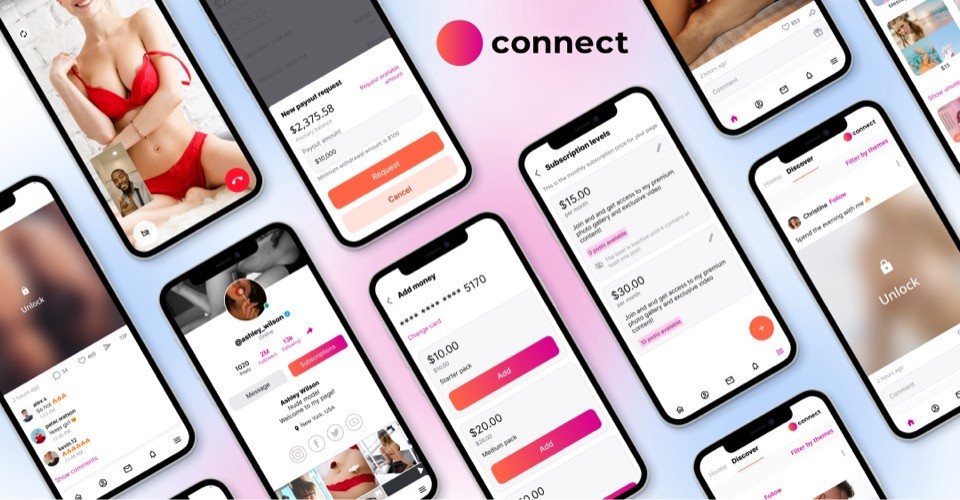Introduction to video chat app development
In today’s digital era, the video chat app market is more vibrant than ever, with users seeking robust video calling features that transcend geographical barriers. Whether it’s for personal connections or remote work, the demand for high-quality video calls is soaring.
Building your own video chat app not only taps into this burgeoning video conferencing market but also caters to the growing expectation for seamless video chatting experiences. With the right app development process, integrating features like screen sharing and virtual noise cancellation, developers can create a video chat app that stands out.
Video Chat Apps Market Overview

Current Market Trends and Statistics
The landscape of video chat apps has witnessed exponential growth, with the video chat market evolving rapidly. The proliferation of mobile apps and the app development process have made video chat features more accessible than ever.
Video calling apps, such as Zoom and Google Meet, have experienced a surge in user numbers. They provide both video and audio calling capabilities. The video conferencing market has witnessed a significant increase in usage. Businesses and individuals rely on video calls for maintaining connectivity.
The Pandemic’s Impact on Video Chat Popularity
There was a surge in video chat app development due to the need to replicate in-person interactions. This development focused on enhancing video quality. It also aimed to ensure stable internet connection speeds for users.
Future Projections for the Video Chat Industry
Looking ahead, the video calling market is expected to continue its upward trajectory. Developments in video chat APIs and the integration of advanced features like video streaming protocols are set to enrich the user experience further. The drive to build video chat apps that cater to both Android and iOS apps users will remain a priority, ensuring a seamless video conferencing feature across platforms. As the app’s functionality evolves, so too will the video conferencing apps, with predictions indicating a robust future for the industry, especially as businesses continue to invest in their own video conferencing app to meet bespoke needs.
In conclusion, the video chat app development process is at the forefront of technological advancement, with the market poised for continued growth. As users demand more sophisticated video calling features, developers are challenged to create video chat solutions that are not just functional but also offer a premium experience. With the right tech stack and a focus on user experience, the potential to make a video chat app that resonates with users is immense.
Understanding Different Types of Video Chat Apps

The landscape of video chat applications is diverse, with each type catering to specific user needs. From simple video calls to comprehensive business conferencing solutions, the variety of apps available reflects the vastness of the market’s demand.
Video Calling Apps
Video calling apps like WhatsApp and Google Duo have become household names, allowing users to make video calls with just a few taps on their smartphones. These apps are designed for personal use, focusing on connecting individuals with their friends and family. The development process for these apps emphasizes user-friendly interfaces and basic features such as:
One-on-one video calls
Group video calls
Direct messaging
Push notifications
Integration with phone contacts
The video calling functionality in these apps is often complemented by high video quality and the ability to operate over various internet connection speeds, ensuring that users can connect from virtually anywhere.
Video Conferencing Apps
For more formal and business-oriented needs, video conferencing apps like Zoom and Microsoft Teams have become the go-to solutions. These platforms offer a video conferencing solution that extends beyond mere chatting through video, incorporating features that facilitate collaboration and business operations:
Screen sharing feature
Virtual meeting rooms
Video conference recording
Integration with business tools
Advanced security protocols
The app development for these video conferencing apps often involves a complex tech stack to ensure stability and scalability, catering to potentially thousands of users simultaneously.
Entertainment and Social Apps
Entertainment and social apps such as Houseparty and Twitch have introduced a new dimension to video chatting, where the experience is not just about communication but also entertainment. These apps blend video streaming with social interaction, offering features like:
Live streaming
Interactive games during video calls
Social media integration
Audience interaction tools
The video app development for these services is unique, often requiring strong streaming protocols and a video audio integration layer that supports real-time interaction without lag.
The Evolving Video Chat Market
As the market for video chat apps continues to expand, the lines between these categories are beginning to blur. Modern video calling apps are starting to incorporate elements from each category to provide a more holistic experience. For instance, a video calling app may now include screen sharing capabilities or allow for video streaming to a broader audience.
The development process for creating a video chat app has become more accessible with the advent of video chat APIs, which allow developers to integrate video conferencing features into existing apps or build a video chat app from the ground up more efficiently.
To sum up, whether it’s to develop a video call app for personal use, a video conferencing application for business, or an entertainment-centric video chatting app, the market is ripe with opportunities. Each type of app serves a distinct purpose, and with the right development approach, businesses can tap into this dynamic and ever-growing field.
Why Invest in Video Chat Apps?

Consumer Demand and Behavior
The surge in consumer demand for video chat apps is undeniable. In a world where connectivity is paramount, users are increasingly turning to video calling apps to bridge the gap between digital and personal interaction.
The convenience of making a video call within just a few minutes, coupled with features like text chat and push notifications, has ingrained chatting through video into daily life. This behavioral shift underscores the importance of video chat app development, as consumers now expect a seamless video calling experience that integrates effortlessly with their lifestyle.
Business Efficiency and Remote Work Trends
The corporate world has embraced video conferencing apps as a cornerstone of business efficiency, especially with the rise of work form home. Video conferencing solutions have proven indispensable for maintaining team collaboration and continuity of operations, regardless of physical location.
The ability to build a video chat feature into existing apps has allowed businesses to create tailored communication ecosystems. This integration has streamlined workflows, from scheduling meetings to sharing documents via screen sharing, all within the video conferencing application.
Advancements in Education and Healthcare
The impact of video technology extends beyond social and business realms into sectors like education and healthcare. Educational institutions are leveraging video chat applications to facilitate remote learning, making education more accessible and interactive.
Video conferencing apps are transforming patient care in healthcare. They enable telehealth services, allowing patients to consult healthcare providers remotely. This is done through audio-video calling, eliminating the need for physical visits.
The Investment Perspective
Investing in video chat app development is not just about tapping into a trend; it’s about anticipating the future of communication. The market for video calling solutions is expanding, with video conferencing apps becoming a staple in various industries.
The development process for video chat apps is becoming more efficient. This is due to the support of video chat APIs and video streaming protocols. Businesses can now quickly deploy their own video conferencing solutions. A well-planned video app development strategy is key. It enables companies to create a video chat feature that improves user experience. This feature also fosters business growth and meets market demands.
Scrile – video chat app development team

Tailored Solutions for Video Chat App Creation
When venturing into the realm of video chat app development, the expertise of a seasoned IT partner like Scrile becomes invaluable. With over two decades of experience in the software development industry, Scrile is adept at crafting applications that are strong, scalable, and tailored to the unique needs of your business.
Whether you’re looking to create a video chat app from the ground up or integrate call capabilities into an existing app, Scrile’s team of experts is equipped to guide you through the intricate app development process.
The Complete Development Cycle Advantage
Scrile’s approach to app development is holistic, encompassing every phase from conceptualization to launch and beyond. This complete development cycle ensures that every aspect of the video chat app — from the user-friendly interface and text chat features to the underlying streaming protocols — is designed with precision and aligned with the client’s vision. By choosing Scrile, you benefit from a streamlined development timeline, which translates to a faster time to market for your video conferencing app.
Building with the Future in Mind
In the dynamic video conferencing market, Scrile’s forward-thinking strategy ensures that your video chat application is not only relevant today but also adaptable to future advancements in technology.
The development team at Scrile is proficient in a spectrum of technologies, enabling us to build video chat apps that are compatible with various platforms, including Google Play and other app stores. Our development process is punctuated with quality assurance, ensuring that the video call app you launch is of the highest quality.
Beyond Development: Continuous Growth and Support
Scrile’s commitment to the clients extends beyond the initial app launch. We understand that the app market is continuously evolving, and so we offer ongoing support and the opportunity for future enhancements. This enduring relationship ensures that your video chat application remains competitive and continues to meet the demands of users and the market.
In summary, Scrile’s comprehensive services, client-centric approach, and mastery of app development make us an ideal partner for building a video chat app. Our ability to offer a complete development cycle, from the initial build to ongoing enhancements, positions us as a strategic ally in the ever-growing video conferencing field. With Scrile, you’re not just developing an app; you’re investing in an experience that will resonate with users and stand the test of time in the business conferencing apps market.
Key Features for a Competitive Video Chat App

As we look towards 2023, the landscape of video chat apps is evolving rapidly. To stay competitive, it’s crucial to integrate a suite of must-have features that cater to the needs and expectations of modern users. Here’s what your app should include:
High-Quality Video and Audio Calls: Crystal-clear video and audio are non-negotiable for users. Your app must ensure minimal latency and high-quality streaming capabilities.
Cross-Platform Compatibility: Users expect to make and receive calls across various devices seamlessly, whether on a phone, tablet, or desktop.
User-Friendly Interface: The app should boast an intuitive design that allows users to navigate and manage calls with ease.
Instant Messaging Integration: Alongside video calling, the ability to send instant messages is essential for a comprehensive communication experience.
Contact Synchronization: Integrate Google Contacts API or other systems to allow users to easily connect with their existing contacts.
End-to-End Encryption: Security is paramount. Ensure all calls and data are protected with robust encryption protocols.
User Interface and Experience Considerations
The user interface (UI) and user experience (UX) are the heart and soul of your video chat app. They determine how users interact with your app and how they feel about it. Consider the following:
Simplicity: A clean and uncluttered UI will enhance usability.
Accessibility: Design with all users in mind, including those with disabilities.
Personalization: Allow users to customize settings to their preferences for a more personal touch.
Advanced Features for Enhanced Communication
To differentiate your app in the market, consider these advanced features:
Screen Sharing: Essential for business and educational users, screen sharing makes collaboration easy and effective.
Virtual Backgrounds: With remote work on the rise, virtual backgrounds help maintain professionalism by hiding personal spaces.
Real-Time Translation: Break down language barriers with real-time translation features, expanding your app’s global usability.
AI-Powered Insights: Use AI to provide users with meeting summaries, highlight important moments, and offer speech-to-text capabilities.
Interactive Elements: Incorporate interactive elements like polls, Q&A sessions, and reactions to engage users.
Self-Hosted Endpoint Infrastructure: For businesses, offering a self-hosted solution can be a significant selling point, providing full control over the app’s functionality and data.
By focusing on these key aspects, you can build a video chat app that not only meets the current market demands but also offers a forward-thinking approach that anticipates future trends. Remember, the goal is to create an app that provides a seamless, secure, and engaging experience that users will return to time and again.
Technical Aspects of Video Chat App Development

Developing a video chat app requires a deep understanding of the underlying technologies that make real-time communication possible. Two fundamental technologies are:
WebRTC (Web Real-Time Communication): This open-source project enables web browsers to communicate directly with each other in real-time, facilitating video and audio communication without the need for additional plugins or apps.
VoIP (Voice over Internet Protocol): VoIP technology allows for the delivery of voice communications and multimedia sessions over the Internet, which is crucial for video calling apps.
Selecting Development Frameworks and Tools
Choosing the right frameworks and tools is pivotal for the efficient and effective development of a video chat app. Considerations include:
Programming Languages: JavaScript, Swift for iOS, and Kotlin for Android are popular choices for building responsive and robust apps.
Frameworks and Libraries: React Native for cross-platform development, or native development frameworks like Android Studio and Xcode for platform-specific apps.
Video Chat API: Utilize pre-built APIs to accelerate development. These can provide essential functionalities like video call setup, management, and teardown.
The Role of Cloud Services and Data Synchronization
Cloud services play a critical role in the scalability and reliability of video chat apps. They provide:
Scalable Infrastructure: Cloud platforms can dynamically adjust to the changing number of users, ensuring consistent performance during peak usage.
Data Synchronization: Real-time data synchronization across devices is essential for a seamless user experience, especially for features like contact lists and message history.
Global Reach: Cloud services often have a global footprint, reducing latency by serving content from the nearest data center to the user.
Building a video chat app is a complex process that involves making informed decisions about the technologies and tools used. Leveraging WebRTC and VoIP is crucial for real-time communication in video calling solutions. Selecting the right development frameworks is another key step. Utilizing cloud services enhances scalability and data synchronization, enabling developers to create powerful and reliable video calling apps. These technical choices will ultimately contribute to the overall user experience, market adoption, and success of the video chat app.
Designing the User Interface

Principles of Effective UI Design
Creating a UI for a video calling app requires adherence to certain principles to ensure effectiveness and user engagement:
Simplicity: The UI should be clean and uncluttered, making it easy for users to make a video call without navigating through unnecessary complexity.
Consistency: Elements like buttons and icons should be consistent in appearance and behavior across the app to avoid confusing users.
Responsiveness: The design must be responsive to accommodate various device sizes, ensuring a seamless experience whether on a video call app for mobile or desktop.
Intuitive Navigation and Accessibility
The success of a video calling solution often hinges on how intuitively users can navigate the app and access its features:
Intuitive Navigation: Users should be able to initiate and manage video calls with just a few taps or clicks. The path to essential features like starting a call, adding participants, and accessing call controls should be obvious.
Accessibility: Designing for accessibility means ensuring that the app is usable by people with disabilities, which can include voice commands, screen readers compatibility, and clear labels.
Developing a video chat app with a user-friendly interface is crucial. It requires a focus on simplicity, consistency, and responsiveness to provide an intuitive and accessible experience. By prioritizing these design principles, developers can build a video calling app that stands out in the market for its ease of use and excellent user experience.
Development Challenges and Solutions

Addressing Common Obstacles
Developing a video calling app comes with its set of challenges, from ensuring high-quality video calling capabilities to integrating a strong video chat API. Common hurdles include:
Network Variability: Users expect clear video and audio, regardless of their network conditions. This requires sophisticated video streaming protocols that adapt to varying bandwidths.
Device Compatibility: A video call app must function seamlessly across a multitude of devices and operating systems, demanding a high level of optimization.
Security Concerns: With the rise of cyber threats, ensuring secure video calls through encryption and secure channels is paramount.
Navigating Challenges with Scrile’s Expertise
Our expertise in video call app development positions us uniquely to navigate these complexities:
Adaptive Solutions: We employ advanced video conferencing APIs and streaming protocols that adjust to the internet connection speed, ensuring a smooth calling experience.
Cross-Platform Development: Our team is adept at creating apps that provide consistent functionality and user experience across all devices.
Security: We prioritize your app’s security, integrating features like end-to-end encryption to protect user privacy.
Building a video chat app involves overcoming significant technical hurdles. With our extensive experience in app development, we can help you develop a video calling app that not only meets market demands but also delivers a secure and user-friendly experience. Trust in our ability to create, build, and launch a video call solution that stands the test of time and technology.
Monetization Strategies for Video Chat Apps

Exploring Monetization Models
Monetizing a video calling app can be approached through various models, each with its unique advantages:
Freemium Model: Offer basic video calling features for free, while reserving advanced functionalities, such as high-definition video call solutions or video chat APIs, for a premium version.
In-App Purchases: Allow users to buy additional features within the app, like custom virtual backgrounds or additional screen sharing capabilities.
Subscriptions: Implement a subscription model for users who require regular, professional-grade video conferencing features.
Balancing Monetization and User Experience
The key to successful monetization lies in maintaining a balance:
User-Centric Approach: Ensure that monetization efforts do not hinder the user experience. Intrusive ads or paywalls can deter users from using the app.
Value Proposition: Users are more likely to invest in an app if they perceive value in the features offered, whether it’s through enhanced video calling capabilities or exclusive content.
Seamless Integration: Monetization features should be integrated smoothly into the app’s interface, ensuring that they complement rather than disrupt the user journey.
Developing a video call app with a thoughtful monetization strategy requires a nuanced understanding of the market and user needs. By building a video chat app that offers a compelling mix of free and paid features, you can create a sustainable revenue stream. It will also provide a high-quality conferencing experience.
Step-by-Step Guide to Building a Video Chat App

1. Ideation and Market Research
Before diving into the development of a video calling app, it’s crucial to start with a solid idea. Research the market to understand the existing apps, user preferences, and potential gaps that your app could fill. Look into:
Current Trends: What features are popular in video call apps now and what might be expected in the future?
Competitor Analysis: What are other calling apps doing, and how can you differentiate your app?
User Demands: Gather data on what users feel is lacking in current offerings.
2. Defining Product Strategy and Target Audience
With insights from your research, define your product strategy:
Unique Value Proposition (UVP): What makes your call app stand out?
Target Audience: Who will use your app? Tailor your app’s features to their needs.
Business Model: How will your app generate revenue? Consider subscriptions, in-app purchases, or ads.
3. Design, Development, and Testing Phases
The design and development phase is where your app starts to take shape:
UI/UX Design: Create a user-friendly design with intuitive navigation. Your app’s interface should make video calling a seamless experience.
Development: Choose the right tech stack. Integrate a robust video chat API and ensure your video streaming protocol is efficient and scalable.
Testing: Rigorous testing is essential. Test for bugs, user experience, and load capacity to ensure a reliable video call solution.
4. Launch and Post-Launch Considerations
Launching your app is just the beginning:
Marketing: Develop a marketing strategy that highlights your app’s features and UVP.
Feedback Loop: After launch, gather user feedback to understand what works and what doesn’t.
Updates and Maintenance: Regularly update your app to fix bugs, improve features, and stay ahead of market trends.
Building a video chat app is a complex process that requires careful planning and execution. Follow these steps to create a successful app. Focus on building a user-centric application. Develop a video calling solution that meets your target audience’s needs and aim to stand out in the market. Remember, the key to success is not just in the launch but in the continuous improvement and adaptation to user feedback and market changes.
Conclusion

The ascent of video call apps has reshaped communication, proving indispensable in our digital era. A strategic approach in developing these apps ensures they deliver value, meeting the evolving demands of users and the market.
For businesses looking to build a video call app, the expertise of an experienced developer like Scrile is invaluable. Scrile’s proficiency in video call app development and our ability to integrate advanced features can elevate an existing app to new heights. Partnering with a developer experienced in the nuances of app creation can make the journey from concept to launch a seamless and successful endeavor.
FAQ
How much does it cost to make a video calling app?
The cost to develop a video calling app can vary widely, starting from tens of thousands to hundreds of thousands of dollars. It depends on the app’s complexity, features, and the rates of the developers you hire.
Is making a chat app difficult?
Creating a calling app involves tackling technical challenges, such as real-time data transmission and user interface design. While it’s complex, with the right expertise and tools, the development process can be streamlined.
How to build a WebRTC application?
To build a WebRTC application, you’ll need to have a solid understanding of WebRTC standards. Also you need to choose the right signaling server, and ensure proper implementation of peer-to-peer communication protocols. It often requires experienced developers to handle the intricacies.
How much does it cost to create an app like Zoom?
Developing an app with functionality similar to Zoom requires a significant investment. It often mirrors or exceedes the cost of a standard video call app. This is due to the need for high-quality video conferencing features, scalability, and robust security measures.
Read also
How to Monetize Social Media: Effective Strategies
Discover effective strategies to monetize your social media presence, including sponsored posts, affiliate marketing, and selling products.
OnlyFans Promotion: Tips for Success
Learn tips and techniques for promoting your OnlyFans account to increase visibility, attract subscribers, and maximize earnings.
Payment Integration for Your Website: Best Practices
Learn the best practices for integrating payment systems into your website, ensuring secure and seamless transactions for your users.
OnlyFans Pricing Guide: Setting the Right Rates
Get a comprehensive guide on setting the right pricing for your OnlyFans content, balancing affordability with profitability.
Best OnlyFans Alternatives: Top Platforms Reviewed
Explore the best alternatives to OnlyFans, comparing features, user experiences, and monetization options to find the right platform for your needs.

